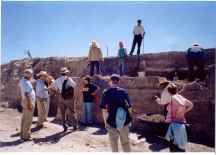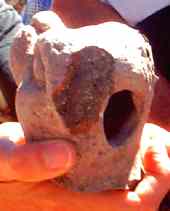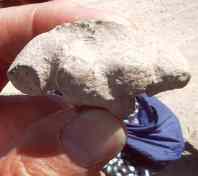
On Wednesday, March 2, 2005, the Oaxacan Study Group visited a salvage excavation site in Etlatongo in the Nochixtlan Valley of the Mixtec Alta, northwest of Oaxaca City Marcus Winter, INAH archaeologist conducted the site tour.
The Etlatongo is a large two level site The lower Formative Period level has an unusually large central plaza that contains a sunken plaza within it and is surrounded by four low mounds The Rio Sardo river runs along the west side of the site.
The substantial Classic Period ruins are north of the site on a hilltop overlooking the plaza and the modern pueblo of San Mateo Etlatongo During the Early Formative Period in the Mixtec Alta, small agricultural villages were established along the alluvial plain near the rivers. In the Nochixtlan Valley, Etlatongo "grew to be as large as contemporaneous San Jose Mogote during the San Lorenzo Horizon (1200-900 bce), serving as the center of a small chiefdom comparable to that in the Valley of Oaxaca." Both probably dominated their areas during the Early and Middle Formative periods In the Late Formative, as conflict increased among the small urban polities, Etlatongo was abandoned like many others in the Mixteca Alta for hilltop defensive locations It was probably superceded by the ridge top site of Yucuita in the Early Urban Stage (Yucuita Phase 500-300 bce) although according to Marc Winter it is possible that the villagers moved instead to Monte Negro which is only a one-day walk away.
During the Classic Period, Etlatongo was re-populated but on the hilltop site Winter believes the Classic Period site plan of pyramid temple-altar-and-ballcourt is reminiscent of Monte Alban, suggesting that Monte Alban may have controlled the area during the Xoo Phase ( 600- 800 ad) but, he said excavations are needed to demonstrate whether this is true In the Late Post-Classic (1200-1400 ad), the valley floor was once again the location of the site and judging from the number of pottery shards, it was densely populated.
The salvage excavation involved two units next to the roadway bordering the South end of the plaza site The initial road clearing revealed a rather large stucco patio floor for a residence
Further excavation exposed two burials beneath the floor with accompanying ceramic artifacts probably of the Cruz D (700-500 bce) or Early Yucuita (500-300 bce) phase Given the size of the paved patio floor and the burials beneath it, this may have been an elite residence
However, both skulls were missing due to initial cutting of the roadway thereby removing other potential clues to burial status such as ear spools, bead necklaces or modification or inlay on teeth Though these indicators of elite status may not apply to Mixtec burials (input needed) At the foot of one skeleton was a large gray ceramic vessel to which a jaguar head had been affixed but was broken off, a possible brazier.
Below the burials down to bedrock were several possible floor strata. The excavation was to proceed to bedrock which could include the Early Formative Phase (1200 - 900 bce) and the possibility of finding San Lorenzo Tenochititlan Olmec style ceramics to analyze for their place of origin Marc Winter was especially interested in finding ceramics from the Mixteca Cruz C Phase (900-700 bce) so that period can be better defined.
The Etlatongo site remains largely unexcavated In 1987, Roberto Zarate Moran conducted several test units and in 1992 Jeffrey Blomster conducted field work including surveying, mapping and additional excavation on which he based his 1998 Ph.D dissertation In 2003, in order to determine the extent of interregional interaction during the Early and Late Formative periods at Etlatongo, Blomster conducted a neutron activation analysis of obsidian samples from the Mixtec Alta The analysis documented that Etlatongo villagers had utilized nine different sources of obsidian, the majority (65%) coming from Paredon, Puebla and others from as far away as El Chayal and Ixtepeque, Guatemala and Ucareo, Michoacan Etlatongo┤s sources also differed from those accessed by Yucuita in both the Early and Late Formative periods though the villages were only 10 km apart The data establishes that Etlatongo participated in a selective variety of wide-ranging exchange networks during the Early Formative period.
Most recently, Jeffrey Blomster, Hector Neff and Michael Glascock extracted Olmec pottery samples from Etlatongo for a neutron analysis of Olmec pottery distribution. This study confirmed that Etlatongo┤s leaders had imported Olmec pottery directly from San Lorenzo and also manufactured Olmec style pottery from local clays Both studies suggest that Etlatongo was an active player in regional exchange in the Early Formative period rather than having a ĘperipheralĘ role in Pan-Mesoamerican interactions as has been suggested
Further findings on the excavation may be forthcoming when the artifact analysis is completed.
Marcus Winter -2004 - Oaxaca, The Archaeological Record
J. Blomster -2003 Diachronic and Synchronic Analyses of Obsidian Procurement in the Mixteca Alta, Oaxaca
J. Blomster, Hector Neff, Michael Glascock - 2005 - Olmec Pottery Production and Export in Ancient Mexico Determined Through Elemental Analysis
Some other photographs - might be worth keeping - Ron

|

|